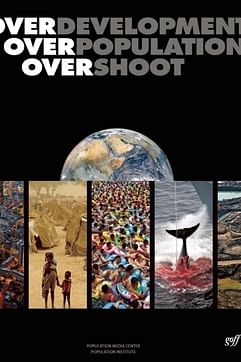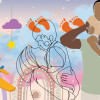Nine times that books told us why overpopulation is scary

"The Population and Housing Census 2022" article published in The Daily Star on July 28 has shown us that the rate of population growth in Bangladesh "has slowed over the past four decades". However, sitting in traffic for what feels like 50 hours, pushing through hoards of people on the streets and shopping malls—basically anywhere in Dhaka, and looking at other socioeconomic issues like housing problems, pollution, the standard of living, population density, and so on, it doesn't feel like overcrowding has ceased to be a problem in and for this country.
Despite the decelerating growth rate and with the country's population currently standing at 16.51 crore as opposed to just 14 crore in 2011—merely 10 years ago—overcrowding is still a massive cause of headache for most of us.
So here are nine books in which the writer—through facts, statistics, and fiction—shows us the consequences and less-than-favourable outcomes of overpopulation.

1. Countdown: Our Last, Best Hope for a Future on Earth?
Alan Weisman
Little, Brown and Company, 2013
To source this work of nonfiction, author Alan Weisman travelled to over 20 countries to ask one very crucial question: How many humans can the planet hold without capsizing? He takes into account issues ranging across cultures, religions, nationalities, tribes, and political systems to learn what in their beliefs, histories, liturgies.
The book outlines how and why the presence of human beings and our ways are pushing the world towards exhaustion, and offers, perhaps "the fastest, most acceptable, practical, and affordable way of returning our planet and our presence on it to balance", according to its blurb.

2. The Caves of Steel (Robot #1)
Isaac Asimov
(Voyager, 1953)
Earth is overpopulated. Spacers and their sidekicks, the robots, have taken over the planet. Galaxies have been colonised, machines have acquired sentiency. Elijah Baley is a police officer who has no love to spare for this "advanced", overcrowded Earth. But when one Spacer is murdered under mysterios circumstances, he receives orders from the "people" above to find his killer. And his assigned partner? A robot.
In this striking science fiction novel, Isaac Asimov sheds light on a potential future full of advancement and technology at the cost of overpopulation and depleting resources.

3. An Essay on the Principle of Population
Thomas Robert Malthus, Geoffrey Gilbert (ed.)
(Oxford University Press, 1798)
Did this author and editor duo from the 18th century foresee the future that is now? Could they have imagined that we would increase to almost 8 billion people this year despite their-alarming-but-our-measly number of growth at "225,000 people per day"?
This book inspects the growth of population leading to hunger, poverty, starvation, and disease and argues that these are phenomena necessary for human lives to sustain. For instance, Malthus explores the outbreak of the Black Plague during the mediaeval ages, when thousands had died and lords faced a shortage of labourers, how wages and benefits increased for the workers who survived. He also predicted that the population would double every 25 years whereas agricultural growth would remain static. Connections like these made the book an extremely influential work in the studies of economy and population.

4. Man Swarm: How Overpopulation is Killing the Wild World
Dave Foreman, Laura Carroll (ed.)
(LiveTrue Books, 2011)
Author Dave Foreman in How Overpopulation is Killing the Wild World claimed to unveil a truth that has already come into play, even before he wrote it—that overpopulation is killing the world.
However, he also claims that this pandemic is solvable.
In simple yet effective ways, Foreman discusses how, if we are aware of our actions, and through proactive stances, we can "solve"—the blurbs suggest—the problem of overpopulation.

5. Billenium
James Graham "J. G." Ballard
(Berkley Publishing Corporation, 1962)
A well rounded collection of sci-fi short stories and novelettes, including "The Gentle Assassin" (1961), "Chronopolis" (1960)", "Prima Belladonna" (1956), "The Garden of Time" (1962), and more. One of the works, "Build-Up" (1957) is a deadpan piece of satire on overpopulation and shares, through the narrator's stream of consciousness, an insight of a dystopian futuristic world, laid waste to decay and hyper advancement.
Ballard's collection is highly recommended for readers with an interest in dystopian literature and ones who are avid readers of science fiction.

6. Overdevelopment, Overpopulation, Overshoot
Tom Butler et al.
(Goff Books, 2015)
In this book the author offers, most of the socioeconomic problems we are now facing—not just in Dhaka, Bangladesh, but all over the world—is made worse by the growing population. The depletion of natural resources, the severe harm caused to the natural ecosystem, the terrible condition to the climate and its associated consequences—why do policymakers and the media continue to overlook these problems, he asks.
OVER is a collection of essays from population experts like Eileen Crist and William Ryerson, and at the heart of it is a series of photo essays illuminating the profound damage that growing population and their behaviour have caused to the Earth, and which threatens humanity's future.

7. Inferno (Robert Langdon #4)
Dan Brown
(Doubleday, 2013)
Robert Landon, the Harvard symbologist, wakes up in a hospital in Italy with a head wound and no recollection of what happened to him in the past 36 hours; he keeps hearing a woman's voice telling him to "seek and find". After finding a cylinder with a biohazard' sign in his jacket, decides to call the US consulate, and learns that they are searching for him. On the other hand, he and his doctor, Sienna Brooks, are being chased by a relentless assassin and are forced to flee.
Through this cat-and-mouse chase, Robert Landon and his companion must unravel a series of codes, created by a brilliant scientist with an obsession to end the world, in order to save humanity.

8. The Population Bomb
Paul R. Ehrlich
(Buccaneer Books, 1968)
Written by a Stanford University professor and his wife, Anne Ehrlich, this book has been widely criticised for its alarmist tone. However, it had successfully predicted worldwide famine in the 1970s and 1980s due to overpopulation, as well as other major societal upheavals. The writer in his work advocates immediate action to limit population growth and extends the idea of "population explosion", that was previously a term more used in the academic circles, to a wider, more mainstream audience.
Much of the book is spent describing the state of the environment and food security. Moreover, Ehrlich argues that as the population at the time was not fed adequately, and as it was growing rapidly, it was unreasonable to expect sufficient improvements in food production to feed everyone.

9. Ender's Game (Ender's Saga #1)
Orson Scott Card
(Tor, 2004)
Andrew "Ender" Wiggin thinks he is playing computer simulated war games, but what he is a part of, is far more menacing. He is the result of a genetic experimentation, a genius, and the hero the Earth is looking for to defeat the Buggers—a race of aliens the planet is at war with for a hundred years that seeks to destroy all human life.
This military sci-fi book explores the dynamics of power, jealousy, vengeance, and tells the story of Wiggin navigating through to tough winds to save the entire human species that anticipates another invasion from its dangerous alien enemies.
Maisha Syeda is a writer, painter, and a graduate of English Literature and Writing. She is the sub editor of Daily Star Books.

 For all latest news, follow The Daily Star's Google News channel.
For all latest news, follow The Daily Star's Google News channel. 











Comments